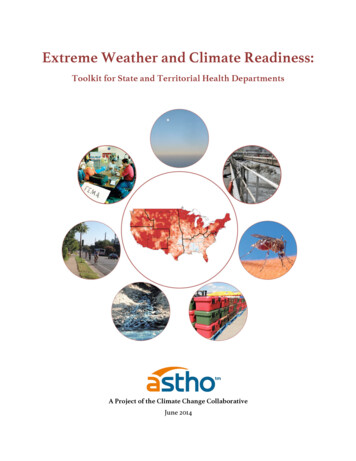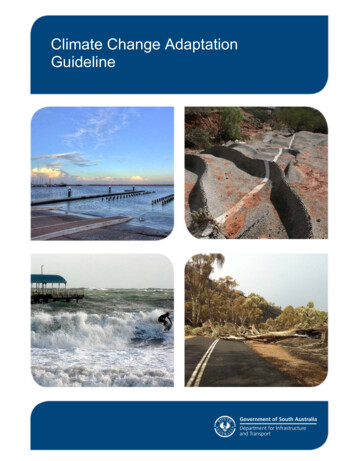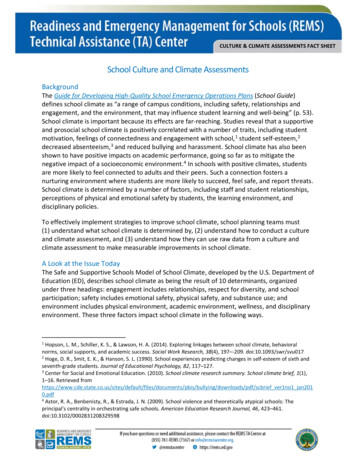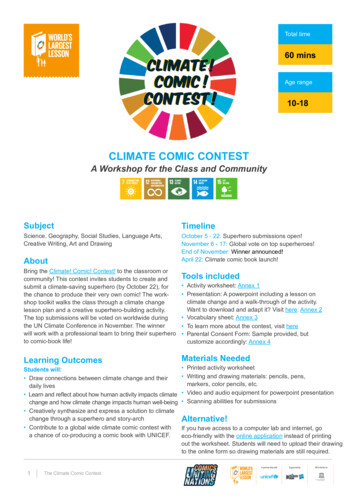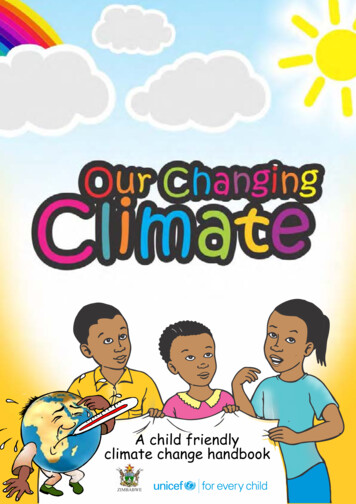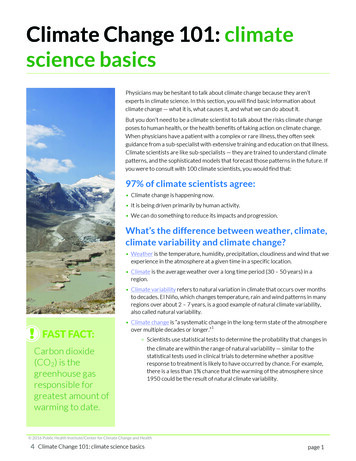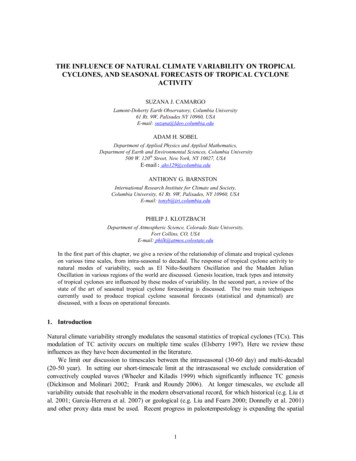
Transcription
THE INFLUENCE OF NATURAL CLIMATE VARIABILITY ON TROPICALCYCLONES, AND SEASONAL FORECASTS OF TROPICAL CYCLONEACTIVITYSUZANA J. CAMARGOLamont Doherty Earth Observatory, Columbia University61 Rt. 9W, Palisades NY 10960, USAE mail: suzana@ldeo.columbia.eduADAM H. SOBELDepartment of Applied Physics and Applied Mathematics,Department of Earth and Environmental Sciences, Columbia University500 W. 120th Street, New York, NY 10027, USAE mail: ahs129@columbia.eduANTHONY G. BARNSTONInternational Research Institute for Climate and Society,Columbia University, 61 Rt. 9W, Palisades, NY 10960, USAE mail: tonyb@iri.columbia.eduPHILIP J. KLOTZBACHDepartment of Atmospheric Science, Colorado State University,Fort Collins, CO, USAE mail: philk@atmos.colostate.eduIn the first part of this chapter, we give a review of the relationship of climate and tropical cycloneson various time scales, from intra seasonal to decadal. The response of tropical cyclone activity tonatural modes of variability, such as El Niño Southern Oscillation and the Madden JulianOscillation in various regions of the world are discussed. Genesis location, track types and intensityof tropical cyclones are influenced by these modes of variability. In the second part, a review of thestate of the art of seasonal tropical cyclone forecasting is discussed. The two main techniquescurrently used to produce tropical cyclone seasonal forecasts (statistical and dynamical) arediscussed, with a focus on operational forecasts.1. IntroductionNatural climate variability strongly modulates the seasonal statistics of tropical cyclones (TCs). Thismodulation of TC activity occurs on multiple time scales (Elsberry 1997). Here we review theseinfluences as they have been documented in the literature.We limit our discussion to timescales between the intraseasonal (30 60 day) and multi decadal(20 50 year). In setting our short timescale limit at the intraseasonal we exclude consideration ofconvectively coupled waves (Wheeler and Kiladis 1999) which significantly influence TC genesis(Dickinson and Molinari 2002; Frank and Roundy 2006). At longer timescales, we exclude allvariability outside that resolvable in the modern observational record, for which historical (e.g. Liu etal. 2001; Garcia Herrera et al. 2007) or geological (e.g. Liu and Fearn 2000; Donnelly et al. 2001)and other proxy data must be used. Recent progress in paleotempestology is expanding the spatial1
2and temporal coverage of the TC record, as well as improving the temporal resolution, datingprecision, and accuracy of intensity estimates (Frappier et al. 2007), but this subject is outside ourscope. Some further discussion can be found in Knutson et al. (this volume)Our knowledge of the relationships between various modes of climate variability and TCs comesmainly from empirical studies, in which statistical methods are used to extract these relationships.Physical insight naturally enters into such studies in a variety of ways, but ultimately ourunderstanding of the mechanisms which determine the relationships is limited by the same factorsthat limit our understanding of the mechanisms of the genesis and intensification of individual TCs.For intensity, we have potential intensity theory (Emanuel 1986; 1988) but this is not a completetheory for the actual intensity of TCs and has been challenged recently (Smith et al. 2008). In anycase, potential intensity theory has been relatively little used in statistical studies of TC variability,with some exceptions (Emanuel 2000; Camargo et al. 2007a; Wing et al. 2007). For TC numbers,we have little theoretical guidance. While there are some theories for aspects of genesis (Bister andEmanuel 1997; Montgomery et al. 2006) and a number of interesting recent developments (e.g.,Raymond et al. 2008; Dunkerton et al. 2008) there is no quantitative theory that goes so far as togive the probability of genesis given some large scale conditions. We know that variables such assea surface temperature, vertical wind shear, and midlevel humidity influence genesis (Gray 1979),and this gives us an empirical basis for understanding how climate variations influence TC numbers.But, first principles understanding is still very limited. Integrated indices such as accumulatedcyclone energy (ACE) and power dissipation depend on intensity, number, and lifetime, and ourability to understand variations in these indices is limited by our lack of understanding of each of theindividual factors.Despite our relative lack of a theoretical foundation for understanding them, the observedrelationships between large scale climate variability and tropical cyclone statistics are strong enoughthat they make it possible to produce statistical forecasts of tropical cyclone activity on seasonal tointerannual time scales. Dynamical forecasts using numerical models are also now feasible, and havehindcast skill that is comparable to the statistical ones.In the first part of this chapter, the TC climate relationship on intraseasonal to decadal time scales will be discussed. In the following section we briefly review the different modes of climatevariability whose influences on TCs have been investigated, and in section 3 we review the influencesthese modes have been found to have, treating each TC basin separately. In the rest of the paper, thestate of the art of seasonal TC forecasting will be reviewed.2. Modes of variabilityThe El Niño – Southern Oscillation (ENSO) is a major mode of natural climate variability. ENSO isgenerated by coupled ocean atmospheric dynamics in the tropical Pacific (e.g. Trenberth, 1997).ENSO is associated with sea surface temperature (SST) changes in the tropical Pacific, as well asshifts in the seasonal temperature, circulation, and precipitation patterns in many parts of the world(Bradley et al. 1987; Ropelewski and Halpert 1987). El Niño and La Niña (warm and cold) eventsusually recur every 3 to 7 years and tend to last for approximately a year. As the ENSOphenomenon can be predicted with some accuracy months in advance (Cane and Zebiak 1985),ENSO forecasts are routinely used as a major component in the making of probabilistic seasonalclimate forecasts (Goddard et al., 2001).ENSO affects TCs strongly in several basins, though its influence is different in each. Theimpact of ENSO on North Atlantic TCs (hurricanes) was first discussed by Gray (1984a), and recent
3reviews of the relationship of ENSO and TCs are presented in Chu (2004) and Landsea (2000).Because of this strong influence and the predictability of ENSO, it is probably the largest singlefactor in seasonal TC forecasts.The North Atlantic basin is the site of several modes of variability, all of which influence TCs.Some aspects of the relationships of these Atlantic modes to each other, and especially of each toglobal climate change, are controversial. We will be brief on this subject here; we discuss it furtherto some extent in the Atlantic subsection of section 3, and Knutson et al. (this volume) discuss therelationship to climate change in particular in more detail.The North Atlantic oscillation (NAO) is the dominant mode of winter climate variability in theNorth Atlantic region (Hurrell et al. 2003); it is closely related to the global “Arctic Oscillation”pattern (Thompson and Wallace 2000). The NAO is a large scale atmospheric seesaw between theAtlantic subtropical high and polar low. It is not a true oscillation, but rather has variation at all timescales, with a red spectrum (Stephenson et al. 2000; Feldstein 2000), and apparently owes itsexistence largely to the interaction of the jet streams with baroclinic eddies (Woolings et al. 2008;Vallis and Gerber 2008).The Atlantic Multi decadal Oscillation (AMO) is a natural mode of variability in the tropicalNorth Atlantic Ocean on multi decadal time scales whose existence has been inferred from analysisof the observed sea surface temperature after removing a linear trend (Folland et al. 1986; Delworthand Mann 2000). It has also been found to exist in coupled numerical models, in which it is amanifestation of variability in the Atlantic Ocean’s thermohaline circulation. Further discussion ofthis mode, and its relationship to other possibly related modes [such as the tropical multidecadalmodes (Chelliah and Bell 2004; Bell and Cheliah 2006)] as well as to anthropogenically forcedglobal climate change, can be found in Knutson et al. (this volume).The Atlantic Meridional Mode (AMM; Servain et al. 1999; Xie and Carton 2004; Chiang andVimont 2004) is a mode of coupled ocean atmosphere variability in the tropical Atlantic. The AMMis a “meridional mode” (Xie 1999; Xie and Carton 2004) associated with meridional displacementsof the intertropical convergence zone and attendant shifts in SST and winds. Recent studies (Vimontand Kossin 2007; Kossin and Vimont 2007) have shown that Atlantic TC statistics are closelyrelated to the AMM. These studies have suggested that the AMM is the most natural descriptor ofvariability associated more often with the AMO or NAO, and that these latter modes affect TCsthrough their projection on the AMM.The Pacific Decadal Oscillation (PDO) is a pattern of Pacific climate variability with a decadaltime scale, impacts in the North Pacific and North American sectors, and secondary signatures in thetropics (Mantua 2002). The spatial pattern of the PDO is similar to that of ENSO, and it is notentirely clear whether the PDO is a truly independent mode or simply the decadal residual of ENSOvariability (e.g., Zhang et al. 1997; Vimont 2005).The quasi biennial oscillation (QBO) is a global scale, zonally symmetric oscillation of the zonalwinds in the equatorial stratosphere (Wallace 1973) which owes its existence to wave mean flowinteraction (Holton and Lindzen 1968; Plumb and McEwan 1978). The QBO has a period ofapproximately 26 months and its largest amplitude occurs near 30 hPa.The Madden Julian Oscillation (MJO; Madden and Julian 1972;1994; Zhang 2005) is thestrongest mode of intraseasonal variability in the tropics. The MJO has a 30 90 day period andconsists of large scale coupled patterns of deep convection and atmospheric circulation, withcoherent signals in many atmospheric variables. The MJO propagates eastward across the globaltropics, with signatures in deep convection primarily in the Indian and western Pacific Oceans. TheMJO is stronger in boreal winter than in boreal summer (e.g. Wang and Rui 1990) and modulates theformation of tropical cyclones in several basins.
43. Regional variability3.1. Western North PacificThere is pronounced interannual variability in TC activity in the western North Pacific, in large partdue to ENSO. Wang and Chan (2002) observed an increase in the number of TCs in the westernNorth Pacific during strong El Niño events, though they found no significant linear relationshipbetween TC number and indices of ENSO. A reduction in the number of TCs occurring in thesummer following an El Niño event has also been found, and is related to the longitudinal shift of theWalker circulation (Chan 1985; Wu and Lau 1992; Chan 2000).ENSO has an important and well documented impact on the mean TC genesis location, with adisplacement to the southeast (northwest) in El Niño (La Niña) years, as shown in Fig. 1 (Chan1985; Chen et al. 1998; Wang and Chan 2002; Chia and Ropelewski 2002). Because of this shift tothe southeast, further away from the Asian continent, typhoons in El Niño years tend to last longer(Wang and Chan 2002) and be more intense than in other years (Camargo and Sobel 2005, Chan2007). In contrast, in La Niña years, the mean genesis location is shifted to the northeast, so that thestorms have shorter lifetimes and tend to be less intense (Camargo and Sobel 2005).Fig. 1. The seasonal mean (July to October) genesis position from 1979 to 1999, “87” is the seasonal mean from 1987,for instance. The triangle shows the long term (1979 99) seasonal mean genesis position at the center of the circle. Theradius of the circle (333 km, i.e., near 3 of latitude) is the standard deviation of the seasonal TC position (Figureoriginally from Chia and Ropelewski 2002).The genesis location shift has been commonly attributed to the eastward extension of themonsoon trough and westerlies (associated with increased cyclonic low level vorticity) and thereduction of vertical wind shear near the date line, both of which enhance the likelihood of genesiseast of the climatological mean genesis point (Lander 1994;1996; Clark and Chu 2002; Wang andChan 2002). The emphasis on these dynamical factors (as opposed to thermodynamic ones) ininterannual variability is consistent with the emphasis placed on the monsoon trough more broadly instudies of TC genesis in the western north Pacific (e.g. Harr and Elsberry 1995; Lander 1996;Ritchie and Holland 1999; Chen et al. 2006). While concurring with this, Camargo et al. (2007e)also presented evidence that a decrease of mid level relative humidity near the Asian continent in ElNiño years may play a role in the eastward shift as well, by suppressing genesis in the western partof the basin.
5ENSO affects not only the starting points and lengths of TC tracks but also the shapes of thetracks. In El Niño years, the TCs have a tendency to recurve northeastward and reach morenorthward latitudes, due both to the shift in mean genesis location and ENSO induced changes in themean steering flow (Wang and Chan 2002; Wu and Wang 2004). Camargo et al. (2007d,e)stratified western North Pacific tropical cyclone tracks into seven clusters. Two clusters which startfrom genesis locations southeastward of the climatological mean and are relatively intense occurmore frequent in El Niño years while the largest cluster type is more typical of La Niña events.Consistent with this, storms affect the southern South China Sea more frequently during La Niñayears (Zuki and Lupo 2008), but affect the Central Pacific more frequently in El Niño years (Chuand Wang 1997; Clark and Chu 2002). Some Central Pacific storms reach the western North Pacific.The ENSO’s influence on western North Pacific TC tracks is reflected in the landfall ratesthroughout the region, with different landfall patterns according to the ENSO phase (Saunders et al.2000; Elsner and Liu 2003). Wu et al. (2004) found a significant relationship between late seasonlandfalls over China and ENSO. Fudeyasu et al. (2006a) noticed an increase in landfalls in theKorean Peninsula and Japan during the early monsoon and in the Indochinese peninsula during thepeak monsoon months in El Niño years. The interannual variability of typhoon landfalls in Chinashows a north south anti correlation in the historical and modern records. This is related to sea levelpressure differences between Mongolia and western China, as well as SST over the western NorthPacific (Fogarty et al. 2006).While ENSO has clearly been shown to influence TCs in the western north Pacific, it has alsobeen argued that TCs may play an active role in the dynamics of ENSO itself. El Niño years featurethe relatively frequent occurrence of tropical cyclone pairs north and south of the equator over thecentral and western Pacific Ocean, associated with westerly wind bursts on the equator (Keen 1982;Lander 1990; Harrison and Giese 1991; Ferreira et al. 1996). It has been argued that the twin TCsthemselves contribute to the generation of the equatorial westerlies and thus amplify El Niño events,through the standard Bjerknes’ mechanism (Keen 1982; Gau 1988). While cyclone pairs arespectacular, they are not actually necessary to this scenario, as a single cyclone can generateequatorial westerlies if it is close to the equator (Harrison and Giese 1991; Kindle and Phoebus1995). Since Pacific cyclones tend to form closer to the equator and reach greater intensities in ElNiño years, there is the possibility of a positive feedback between ENSO and TCs, with single aswell as twin cyclones playing a role (e.g., Sobel and Camargo 2005; see also Yu and Rienecker1998; Yu et al. 2003; Eisenman et al. 2005). On the other hand, the causality is difficult to extractfrom observations, because equatorial westerlies are associated with off equatorial cyclonic vorticityand other conditions conducive to genesis. It is possible that the westerlies occur primarily for otherreasons and that cyclones are largely a passive by product, as argued by Lander (1990).The relationship of the quasi biennial oscillation (QBO) to TC activity in the western NorthPacific was examined by Chan (1995), who found that in the westerly phase of the QBO, there aremore TCs in the western North Pacific. Chan (2005) attributed this to a decrease in the upper tropospheric vertical shear over the tropics in the westerly phase. The QBO TC relationship will bediscussed further in the Atlantic subsection, below. The relationship has been studied more in theAtlantic, and the QBO itself is quite axisymmetric and should, a priori, be expected to affect allbasins similarly.Associations on the interannual time scales between western north Pacific TCs and a number ofother factors, besides ENSO, have been found. These factors include Tibetan plateau snow cover(Xie et al. 2005b; Xie and Yan 2007), North Pacific sea ice cover (Fan 2007), the large scalecirculation in the extratropical southern hemisphere (Ho et al. 2005; Wang and Fan 2007), and
6various other empirically derived oscillations such as the Asian Pacific oscillation (Zhou et al. 2008),and the North Pacific oscillation (Wang et al. 2007).A few studies have examined the decadal and multi decadal variability of tropical cycloneactivity in the western North Pacific. The subject is important, but any results on this time scale mustbe interpreted with great caution due to the shortness of the data record. The observational record inthe western north Pacific is unreliable before the 1950s, and perhaps even before the 1970s (e.g. Wuet al. 2006). Matsuura et al. (2003) related the decadal variability in the western North Pacific tolong term variations of sea surface temperature in the tropical Central Pacific and westerly windsanomalies associated with the monsoon trough. Chan (2008) examined the decadal variability ofintense typhoon occurrence. Using wavelet analysis, besides the ENSO time scale (3 7 years), heidentified another major oscillation with a multi decadal period (16 32 years) for intense typhoons,and argued that the environmental conditions conducive to periods of intense typhoons occurrence arelargely modulated by ENSO and the Pacific Decadal Oscillation. The decadal variability of TCtracks has also been largely attributed to the Pacific Decadal Oscillation (Liu and Chan 2008). Ho etal. (2004) associated the inter decadal changes of typhoon tracks with the westward expansion of thesubtropical North Pacific High since 1970. The regions with the greatest inter decadal changesidentified in Ho et al. (2004) are the East China Sea and the Philippine Sea.On the intraseasonal time scale, tropical cyclone activity in the western north Pacific is stronglymodulated by the MJO. The MJO changes the distribution of TC tracks (Camargo et al. 2007e), andgenesis is favored during the active phase of enhanced deep convection (Nakazawa 1986; Liebmannet al. 1994). The environment during the active phase is favorable to genesis in multiple ways.Midlevel humidity and low level relative vorticity are both enhanced during the active phase, and theincreased occurrence of convection is more likely to generate potential seed disturbances which canundergo genesis. Sobel and Maloney (2000) argued that MJO induced modulation of waveaccumulation (Chang and Webster 1988; Holland 1995; Sobel and Bretherton 1999; Kuo et al.2001), by which large scale convergence can amplify synoptic scale disturbances which can beprecursors to TC genesis, might play a role. The idealized numerical calculations of Aiyyer andMolinari (2003) show in particular how MJO related circulation anomalies can, through drydynamics alone, amplify mixed Rossby gravity waves and change their structure to be “tropicaldepression type” (e.g., Takayabu and Nitta 1993) and thus more favorable candidates for genesis.3.2. Central and Eastern North PacificDuring its peak season, the eastern North Pacific is the most active tropical cyclogenesis region perunit area (Molinari et al. 2000). Tropical cyclogenesis in the eastern North Pacific is influenced bywind surges, African easterly waves, topographical effects, ITCZ breakdown, upper level potentialvorticity, and the confluence between the monsoon westerlies and trade easterlies (e.g., Avila 1991;Bosart and Bartlo 1991; Zehnder 1991; Bister and Emanuel 1997; Ferreira and Schubert 1997;Zehnder et al 1999; Molinari and Vollaro 2000; Vincent and Fink 2001).There has been considerable investigation into the influence of ENSO on TC activity in theeastern north Pacific. With very few exceptions (e.g., Whitney and Hobgood 1997), these studieshave found clear relationships between ENSO and various measures of TC activity. Frank andYoung (2007) obtained a strong relationship between storm counts and a multi variate ENSO index.Gray and Sheaffer (1991) found an increased number of intense hurricanes during El Niño events.Several studies have found a westward shift in the mean genesis region during El Niño events (Irwinand Davis 1999; Kimberlain 1999; Chu and Zhao 2007; Wu and Chu 2007; Camargo et al. 2008a).
7A consequence of this westward shift is that more hurricanes propagate into the central North Pacificregion (Chu 2004).Some studies have attempted to understand the environmental factors by which ENSO influenceseastern north Pacific TCs. Using composites of a genesis potential index keyed to the ENSO state,Camargo et al. (2007a) concluded that wind shear is the main contributor, with potential intensityalso playing a contributing role. Collins and Mason (2000) identified differing environmentalparameters affecting TC activity for the regions east versus west of 116 W. They observed that inthe eastern part of the region, the environmental parameters are nearly always at levels conducive toTC formation during the peak season, while in the western region, there are some years when theparameters are conducive to cyclogenesis but other years when they are less so.Several studies have found a see saw of TC activity between the North Atlantic and the easternNorth Pacific, with enhanced activity in the eastern Pacific when the Atlantic is suppressed, and vice versa (Elsner and Kara 1999). Stronger anti correlations are found for stronger TCs (Frank andYoung 2007). It is not entirely clear whether this is simply a result of the fact that ENSO influencesthe two basins in opposite ways (which is certainly the case), or whether in fact the TC activity inone basin directly influences that in the other by another route.On decadal time scales, Zhao and Chu (2006) examined the variability of TC activity in theeastern North Pacific using a Bayesian multiple change point analysis. Their results indicated thathurricane activity in the eastern North Pacific had two inactive eras (1972 1981, 1999 2003) and anactive era during 1982 1998.The probability of cyclogenesis in the eastern North Pacific is strongly modulated by the MJO,as shown in Fig. 2 (Molinari et al. 1997; Molinari and Vollaro 2000; Maloney and Hartmann2000b,2001; Aiyyer and Molinari 2008; Camargo et al. 2008a). In the convective MJO phase,anomalous westerlies and cyclonic vorticity occur over the eastern Pacific and Gulf of Mexico. Fourtimes the number of tropical cyclones form in the active phase of the MJO than in the suppressedphase. Additionally, storms forming in the active MJO phase tend to do so closer to the Mexicancoast, further increasing the chance of hurricane landfall compared to the suppressed phase (Maloneyand Hartmann 2000b).Various studies have suggested that to a first order, barotropic dynamics can be used tounderstand the influence of the MJO on eastern north Pacific TCs. Significant barotropic energyconversion from the mean state to the eddies occurs during the convective phase of the MJO(Molinari et al. 1997; Maloney and Hartmann 2001; Hartmann and Maloney 2001; Aiyyer andMolinari 2008). This is consistent with, but more general than, the hypothesis of wave accumulationmade in the western North Pacific by Sobel and Maloney (2000); wave accumulation involvesbarotropic conversion, but the conversion can also happen by other means such as barotropicinstability. Aiyyer and Molinari (2008) noticed that in the active phase of the MJO, the vertical shearis relatively weak and tropical cyclones tend to form mainly within the ITCZ. In contrast, during thesuppressed phase, the vertical wind shear exceeds 10 m s 1 over much of the region, and tropicalcyclone development is shifted northward, nearer the Mexican Pacific coast. While these studieshave focused on dynamics over thermodynamics, recent work (Camargo et al., 2008b) using agenesis potential index to compare thermodynamic and dynamic factors in a quantitative waysuggests that MJO induced variations in thermodynamic variables, particularly midlevel humidity,are important. This is consistent with results from the EPIC field experiment on the MJO’s influenceon generalized ITCZ convection (Raymond et al. 2003).
8Fig. 2. Number of hurricanes as a function of MJO phase for the eastern North Pacific during May – November for1979 95. Error bars represent 95% confidence level (Figure originally from Maloney and Hartmann 2000a).The central North Pacific is sometimes considered as a distinct TC basin, though it can sharestorms (during the course of their lifetime) with either the eastern or western North Pacific. Tropicalcyclone occurrence in the central North Pacific is low, with an average of four to five TCs per year.In El Niño years, the number is greater. The higher level of activity in the central North Pacific inwarm ENSO events has been attributed to smaller vertical shear and greater low level vorticity inthat region (Wu and Lau 1992; Chu and Wang 1997; Clark and Chu 2002; Camargo et al. 2007a).Chu and co workers (Chu and Clark 1999; Chu 2002; Chu and Zhao 2004) also examined thedecadal scale variability in the central North Pacific. They found change points in 1982 and 1995,with fewer cyclones during the 1966 1981 and 1995 2000 periods, and more during the 1982 1994epoch. In the more active period, warmer sea surface temperatures, lower sea level pressure, strongerlow level anomalous cyclone vorticity, reduced vertical wind shear, and increased total precipitablewater were present in the tropical North Pacific, compared to the reduced activity periods. Theatmospheric steering flows also were also different in October and November of the active period, sothat eastern North Pacific cyclones had a higher chance of entering the central North Pacific. Duringthe more active period, the storms that formed within the region were more likely to affect theHawaiian Islands.3.3. North AtlanticNorth Atlantic TC activity has a strong relationship with ENSO. Gray (1984a;b) used thisrelationship to develop the first Atlantic TC seasonal forecasts. In El Niño years, hurricane activityin the Atlantic is reduced, while in La Niña, it is enhanced. The negative correlation of Atlantic TCactivity with ENSO is evident in a wide range of TC activity indices: the number of hurricanes,number of hurricane days, number of tropical storms and ACE (accumulated cyclone energy). Theinfluence of ENSO is very significant for the number of intense hurricanes, as in La Niña years thereare usually twice as many intense hurricanes as in El Niño years. The correlations of the number ofintense hurricanes with ENSO indices are higher than for weaker storms (Gray et al. 1993; Landseaet al. 1999).ENSO is generally thought to influence Atlantic TC activity by altering the large scaleenvironment for genesis and intensification, particularly in the so called Main Development Region(MDR), where many tropical cyclones form from African easterly waves. During an El Niño year,the vertical wind shear is larger than normal in most of the tropical Atlantic and especially in theCaribbean. This inhibits the formation of TCs. Reductions in vertical wind shear typically occur inLa Niña years (e.g., Goldenberg and Shapiro 1996, Knaff 1997). Besides these dynamical influencesof ENSO, thermodynamic effects have also been identified. Knaff (1997) argued that increased
9midlevel dryness during El Niño events might be responsible for some of the TC suppression duringthose events, while Tang and Neelin (2004) argued for the importance of increased moist stability,due to increased tropospheric temperature during El Niño (e.g., Yulaeva and Wallace 1994; Soden2000; Sobel et al. 2002). Camargo et al. (2007a) used variants on an empirical genesis index tocompare the dynamic and thermodynamic effects of ENSO directly, and found the dynamic effects ofwind shear to be more important than the thermodynamic effects in the North Atlantic. In addition tomodulating Atlantic TC activity as a whole, ENSO also influences the probability of landfallinghurricanes in the U.S., with an increased probability of landfall in La Niña years (O’Brien et al.1996; Bove et al. 1998; Pielke and Landsea 1998; Larson et al. 2005). The probability of two ormore hurricane landfalls during a La Niña event is 66%, while in El Niño years it is 28% (Bove et al.1998). On a more regional basis, the differences in landfall frequencies in the cold and warm ENSOphases are particularly significant for the U.S. East coast (Georgia to Maine), and smaller for theFlorida and Gulf coasts (Smith et al. 2007). On a still finer scale, significant differences betweenspecific U.S. Southeast states have been found (Xie et al. 2002). U.S. hurricane losses,unsurprisingly, are also significantly related to ENSO, with much more damage occurring in La Niña
Oscillation in various regions of the world are discussed. Genesis location, track types and intensity of tropical cyclones are influenced by these modes of variability. In the second part, a review of the state of the art of sea


